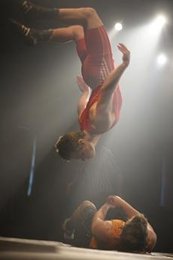Imagine the Rubber Bandits in a cage fight somewhere in the middle of Afghanistan and you come close to getting the concept for this show. Muscular wrestlers in latex masks command the stage with explosive energy, circling each other like fighting dogs, roaring and trash-talking. Paul Mercier and Fibín have re-imagined the myth of Sétanta for the twenty-first century with multiple contemporary references seamlessly woven into this ancient story.
In Scotland, Sétanta and his friend Ferdia are young wrestlers at the top of their game. Sétanta’s manager persuades him that glory awaits him in Emain Macha and he is persuaded to leave Scotland and return to the war-torn country to fight and ultimately take up arms against the dictator Medb. He leaves behind the pregnant Aoife, hooks up again with former lover Eimear, and proceeds to beat off all opponents with ease in a series of gruelling physical contests, sometimes to the death.
From the vicious body slams in the wrestling ring to equally energetic bouts under billowing silken sheets, this show represents a feat of astonishing physical performance for all five actors: Mairéad Conneely, Stephen Darcy, Eoin Geoghegan, Grace Kiely, Seán T. Ó Meallaigh. No one name is credited with designing the movement and fight scenes, which are expertly choreographed and performed. Fifty exquisitely crafted masks by Matthew Guinnane permit multiple changes of character, age and gender. Looking at mask after mask, you feel like you know these people – a Barry McGuigan lookalike wrestling  promoter and an intimidating, pointy-nosed Medb – the faces are exaggerated and yet familiar. Each mask is fixed in one static expression, yet whatever emotion they express is a ramped-up version of the human equivalent: scarier, sadder, angrier, and more seductive that the human face. Stage management skills beyond the norm are required to juggle five actors and fifty masks in ninety minutes – no wonder that stage manager Jane Talbot appeared on stage at the end of the show for some well-deserved applause.
promoter and an intimidating, pointy-nosed Medb – the faces are exaggerated and yet familiar. Each mask is fixed in one static expression, yet whatever emotion they express is a ramped-up version of the human equivalent: scarier, sadder, angrier, and more seductive that the human face. Stage management skills beyond the norm are required to juggle five actors and fifty masks in ninety minutes – no wonder that stage manager Jane Talbot appeared on stage at the end of the show for some well-deserved applause.
References to contemporary life and politics are strewn like landmines throughout the play – politicians and terrorists alike are viciously satirised. Professional sport is portrayed as a brutal industry: selling glory to young people in return for their freedom and often their lives. The media exploit war for their own ends. The modern-day references add to the thrust of the story. In fact, the narrative and the staging are so strong that this show could be enjoyed anywhere from Vladivostok to Chicago. This show can be appreciated by those who understand every word, but in no way excludes those who don’t.
The language of the piece veered from the poetic: “Strength is the illusion of freedom”, to the conversational: “Don’t trust the Taoiseach, sure he’s only a puppet.” Puppetry as a metaphor surfaces throughout, reflecting Fibín’s origins as a puppet company. There are no puppets on stage here, but some of the more hilarious characters are puppet-like, particularly the MacDougall Brothers, cage fighter versions of Podge and Rodge.
Film projection is used throughout, particularly in the play-within-a-play story of the Curse of Macha – a piece which would happily stand on its own. Film projections can sometimes be an awkward add-on to a production, but in this case the screen itself appears to melt into the scene. Music by Mel Mercier and lighting by Mark Galione were both suitable foils to the actors’ fireworks. Blánaid Ní Nuanáin’s subtly imaginative costumes enhanced the roles created by Guinnane’s masks.
One drawback in this thoroughly engaging retelling of the Sétanta myth is the lack of time spent on developing the Sétanta/Ferdia bond. They are together at the beginning of the piece for a brief time only. The interval in the narrative is too long before Ferdia reappears in Sétanta’s life - with tragic results. For audiences unfamiliar with the mythology, some of the impact of the ending is lost, as the intensity of the relationship between the pair, both as men and boys, is insufficiently developed onstage.
The Peacock stage has seen many productions in the Irish language, but a new play in Irish by a prominent Irish playwright is hardly an everyday thing. In the past, plays performed in Irish have suffered from being analysed firstly as “a play in Irish” and secondly as a play. Sétanta demands a different response. The performance is so unapologetically physical, that the question of language seems redundant; the language of the play is beautiful, but the fact that it is Irish rather than English is hardly worth commenting on. Irish theatre companies have been pushing back the boundaries of movement and dance for some years now, but with Fibín’s Sétanta, physical theatre has come of age. As Eimear said after putting in a few rounds of her own with Sétanta: “It was worth the wait...”
Ruth Kennedy is a researcher with The Morning Show on East Coast FM and also works in theatre in education.